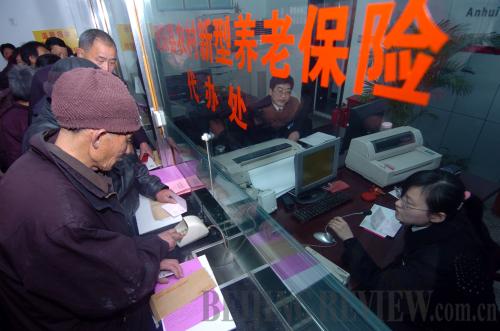 |
|
SECURITY FIRST: Villagers in Feidong, Anhui Province withdraw their retirement benefits at a rural cooperative bank (GUO CHEN) |
Wan Xianchu, a resident of Hunan Province who will soon retire, said he's indifferent to how the government invests the pension fund.
"As long as I can get the pension each month after retirement, they can do whatever they want," Wan said. He has confidence that the government will not play with fire when dealing with people's life savings.
"Even if they do lose a large portion of the money, I strongly believe we can get our money back," said Wang Peihua, a retired worker in Jiangsu Province. "After all, how can the government lose money?"
Wang's confidence in the government's ability to reap profits comes after she lost two thirds of her total investment since 2007. Professionals, she said, are more capable of managing individual or collective capital.
Wang's monthly pension is now 1,010 yuan ($154), with an annual increment of 10 percent. Jiangsu Province implemented a rule years ago that anyone who pays the pension for 15 years can get retirement benefits each month with an increment of 10 percent each year. Wang contended the government would keep its promise and play by the rules.
Despite retired people's confidence in the government, the generation of those born in the 1970s and 1980s, now the backbone of China's national economic development, are strongly opposed to the idea of putting their pension in the government's hands.
"Our country's supervision over public fund has always been weak and insufficient," said Jiang Chao, a 32-year-old engineer in Beijing. "If the pension fund loses money, then the people have to pick up the check."
Putting the entire fund into the stock market is certainly an unwise move, said Zheng Bingwen, a CASS research fellow on social security. But putting limits would be set to ensure that no more than 50-60 percent is invested, and only when the market is healthy, he said. Zheng also suggested a diversified investment portfolio.
"Some can invest in the capital market, some can invest in the real industry, while others can buy fixed-yield financial products," he said.
Three Pillars of China's Pension System
Old-Age Funds
These funds form part of the government-operated social security system. This public pension system is funded through a "social pooling" fund and "personal accounts," introduced in 2000 and funded by both employers and legislated contributions by employers. The "social pooling" fund is almost exclusively invested in secured bank deposits and domestic government bonds, although personal account assets, which are managed and administered at the provincial level, are in theory allowed to invest more freely and assume greater risk in pursuit of higher returns.
Occupational Pension Plans
These plans typically take the form of supplemental old-age insurance annuities. While such occupational pension plans are still in their infancy—since 2004 occupational annuities account for an estimated 1 percent of the pension-fund assets—there is tremendous scope for further growth and developments, as a means to introduce individual decision making and responsibility and reduce the reliance on the public pension system.
National Social Security Fund
Established in 2000, the fund is akin to the sovereign superannuation or reserve funds found in many countries. The fund was established to meet expected increases in future pension liabilities associated with China's aging population and is funded primarily by fiscal transfers that arise from earnings on state-owned shares (largely in financial institutions) and other forms of investment income. The fund was initially invested exclusively in the domestic markets, but there has been an increasingly willingness to increase its investment exposure to foreign capital markets.
(Source: New Proposals for Meeting China's Pension Challenge by Zheng Bingwen, CASS)
Email us at: liuyunyun@bjreview.com | 